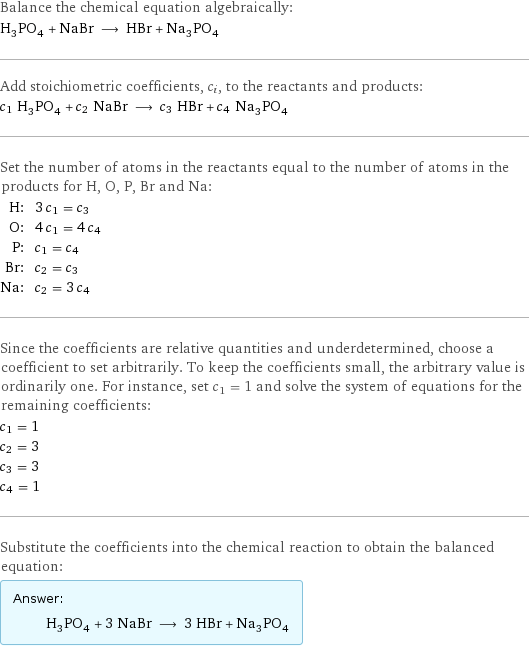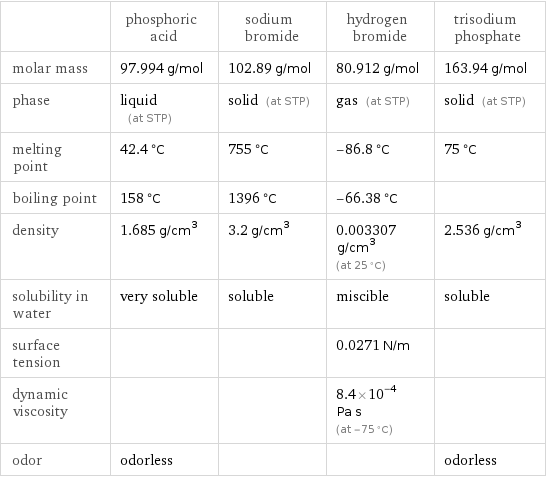Input interpretation

H_3PO_4 phosphoric acid + NaBr sodium bromide ⟶ HBr hydrogen bromide + Na_3PO_4 trisodium phosphate
Balanced equation

Balance the chemical equation algebraically: H_3PO_4 + NaBr ⟶ HBr + Na_3PO_4 Add stoichiometric coefficients, c_i, to the reactants and products: c_1 H_3PO_4 + c_2 NaBr ⟶ c_3 HBr + c_4 Na_3PO_4 Set the number of atoms in the reactants equal to the number of atoms in the products for H, O, P, Br and Na: H: | 3 c_1 = c_3 O: | 4 c_1 = 4 c_4 P: | c_1 = c_4 Br: | c_2 = c_3 Na: | c_2 = 3 c_4 Since the coefficients are relative quantities and underdetermined, choose a coefficient to set arbitrarily. To keep the coefficients small, the arbitrary value is ordinarily one. For instance, set c_1 = 1 and solve the system of equations for the remaining coefficients: c_1 = 1 c_2 = 3 c_3 = 3 c_4 = 1 Substitute the coefficients into the chemical reaction to obtain the balanced equation: Answer: | | H_3PO_4 + 3 NaBr ⟶ 3 HBr + Na_3PO_4
Structures

+ ⟶ +
Names

phosphoric acid + sodium bromide ⟶ hydrogen bromide + trisodium phosphate
Equilibrium constant
![Construct the equilibrium constant, K, expression for: H_3PO_4 + NaBr ⟶ HBr + Na_3PO_4 Plan: • Balance the chemical equation. • Determine the stoichiometric numbers. • Assemble the activity expression for each chemical species. • Use the activity expressions to build the equilibrium constant expression. Write the balanced chemical equation: H_3PO_4 + 3 NaBr ⟶ 3 HBr + Na_3PO_4 Assign stoichiometric numbers, ν_i, using the stoichiometric coefficients, c_i, from the balanced chemical equation in the following manner: ν_i = -c_i for reactants and ν_i = c_i for products: chemical species | c_i | ν_i H_3PO_4 | 1 | -1 NaBr | 3 | -3 HBr | 3 | 3 Na_3PO_4 | 1 | 1 Assemble the activity expressions accounting for the state of matter and ν_i: chemical species | c_i | ν_i | activity expression H_3PO_4 | 1 | -1 | ([H3PO4])^(-1) NaBr | 3 | -3 | ([NaBr])^(-3) HBr | 3 | 3 | ([HBr])^3 Na_3PO_4 | 1 | 1 | [Na3PO4] The equilibrium constant symbol in the concentration basis is: K_c Mulitply the activity expressions to arrive at the K_c expression: Answer: | | K_c = ([H3PO4])^(-1) ([NaBr])^(-3) ([HBr])^3 [Na3PO4] = (([HBr])^3 [Na3PO4])/([H3PO4] ([NaBr])^3)](../image_source/2e6bd121b5f1eeeecfa4100600a0281e.png)
Construct the equilibrium constant, K, expression for: H_3PO_4 + NaBr ⟶ HBr + Na_3PO_4 Plan: • Balance the chemical equation. • Determine the stoichiometric numbers. • Assemble the activity expression for each chemical species. • Use the activity expressions to build the equilibrium constant expression. Write the balanced chemical equation: H_3PO_4 + 3 NaBr ⟶ 3 HBr + Na_3PO_4 Assign stoichiometric numbers, ν_i, using the stoichiometric coefficients, c_i, from the balanced chemical equation in the following manner: ν_i = -c_i for reactants and ν_i = c_i for products: chemical species | c_i | ν_i H_3PO_4 | 1 | -1 NaBr | 3 | -3 HBr | 3 | 3 Na_3PO_4 | 1 | 1 Assemble the activity expressions accounting for the state of matter and ν_i: chemical species | c_i | ν_i | activity expression H_3PO_4 | 1 | -1 | ([H3PO4])^(-1) NaBr | 3 | -3 | ([NaBr])^(-3) HBr | 3 | 3 | ([HBr])^3 Na_3PO_4 | 1 | 1 | [Na3PO4] The equilibrium constant symbol in the concentration basis is: K_c Mulitply the activity expressions to arrive at the K_c expression: Answer: | | K_c = ([H3PO4])^(-1) ([NaBr])^(-3) ([HBr])^3 [Na3PO4] = (([HBr])^3 [Na3PO4])/([H3PO4] ([NaBr])^3)
Rate of reaction
![Construct the rate of reaction expression for: H_3PO_4 + NaBr ⟶ HBr + Na_3PO_4 Plan: • Balance the chemical equation. • Determine the stoichiometric numbers. • Assemble the rate term for each chemical species. • Write the rate of reaction expression. Write the balanced chemical equation: H_3PO_4 + 3 NaBr ⟶ 3 HBr + Na_3PO_4 Assign stoichiometric numbers, ν_i, using the stoichiometric coefficients, c_i, from the balanced chemical equation in the following manner: ν_i = -c_i for reactants and ν_i = c_i for products: chemical species | c_i | ν_i H_3PO_4 | 1 | -1 NaBr | 3 | -3 HBr | 3 | 3 Na_3PO_4 | 1 | 1 The rate term for each chemical species, B_i, is 1/ν_i(Δ[B_i])/(Δt) where [B_i] is the amount concentration and t is time: chemical species | c_i | ν_i | rate term H_3PO_4 | 1 | -1 | -(Δ[H3PO4])/(Δt) NaBr | 3 | -3 | -1/3 (Δ[NaBr])/(Δt) HBr | 3 | 3 | 1/3 (Δ[HBr])/(Δt) Na_3PO_4 | 1 | 1 | (Δ[Na3PO4])/(Δt) (for infinitesimal rate of change, replace Δ with d) Set the rate terms equal to each other to arrive at the rate expression: Answer: | | rate = -(Δ[H3PO4])/(Δt) = -1/3 (Δ[NaBr])/(Δt) = 1/3 (Δ[HBr])/(Δt) = (Δ[Na3PO4])/(Δt) (assuming constant volume and no accumulation of intermediates or side products)](../image_source/66c51bf45ec54fe9ed6029422f647d3b.png)
Construct the rate of reaction expression for: H_3PO_4 + NaBr ⟶ HBr + Na_3PO_4 Plan: • Balance the chemical equation. • Determine the stoichiometric numbers. • Assemble the rate term for each chemical species. • Write the rate of reaction expression. Write the balanced chemical equation: H_3PO_4 + 3 NaBr ⟶ 3 HBr + Na_3PO_4 Assign stoichiometric numbers, ν_i, using the stoichiometric coefficients, c_i, from the balanced chemical equation in the following manner: ν_i = -c_i for reactants and ν_i = c_i for products: chemical species | c_i | ν_i H_3PO_4 | 1 | -1 NaBr | 3 | -3 HBr | 3 | 3 Na_3PO_4 | 1 | 1 The rate term for each chemical species, B_i, is 1/ν_i(Δ[B_i])/(Δt) where [B_i] is the amount concentration and t is time: chemical species | c_i | ν_i | rate term H_3PO_4 | 1 | -1 | -(Δ[H3PO4])/(Δt) NaBr | 3 | -3 | -1/3 (Δ[NaBr])/(Δt) HBr | 3 | 3 | 1/3 (Δ[HBr])/(Δt) Na_3PO_4 | 1 | 1 | (Δ[Na3PO4])/(Δt) (for infinitesimal rate of change, replace Δ with d) Set the rate terms equal to each other to arrive at the rate expression: Answer: | | rate = -(Δ[H3PO4])/(Δt) = -1/3 (Δ[NaBr])/(Δt) = 1/3 (Δ[HBr])/(Δt) = (Δ[Na3PO4])/(Δt) (assuming constant volume and no accumulation of intermediates or side products)
Chemical names and formulas

| phosphoric acid | sodium bromide | hydrogen bromide | trisodium phosphate formula | H_3PO_4 | NaBr | HBr | Na_3PO_4 Hill formula | H_3O_4P | BrNa | BrH | Na_3O_4P name | phosphoric acid | sodium bromide | hydrogen bromide | trisodium phosphate
Substance properties

| phosphoric acid | sodium bromide | hydrogen bromide | trisodium phosphate molar mass | 97.994 g/mol | 102.89 g/mol | 80.912 g/mol | 163.94 g/mol phase | liquid (at STP) | solid (at STP) | gas (at STP) | solid (at STP) melting point | 42.4 °C | 755 °C | -86.8 °C | 75 °C boiling point | 158 °C | 1396 °C | -66.38 °C | density | 1.685 g/cm^3 | 3.2 g/cm^3 | 0.003307 g/cm^3 (at 25 °C) | 2.536 g/cm^3 solubility in water | very soluble | soluble | miscible | soluble surface tension | | | 0.0271 N/m | dynamic viscosity | | | 8.4×10^-4 Pa s (at -75 °C) | odor | odorless | | | odorless
Units
